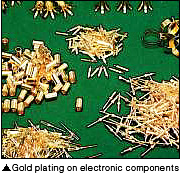#137 Electrical Properties of Functional Plating
Electrical properties required for the functional plating are as follows.
|
(1) Electrical conductivity
The most conductive metal is Silver, followed by Copper, Gold, and Tin. Therefore, these metal platings are utilized on applications requiring good electrical conductivity. In the electronics field, copper plating is indispensable for the through-hole plating to electrically connect both sides of PC boards. Gold, silver, tin, and nickel platings are used on contacts, connectors, and switches. Since gold and silver of high purity produce soft film, alloyed platings of higher hardness are applied.
(2) High frequency characteristics
This is a characteristic in regards to conductivity on millimeter waves and microwaves. On microwave waveguides, it is important that the waveguide surfaces are smooth for low transmission loss performance. For this, copper plating and copper electro-forming are used.
(3) Magnetism
Both dynamic and static magnetic properties are required for magnetic recording media applications. Alloyed platings such as Nickel-Cobalt, Nickel-Cobalt-Phosphorus are utilized.
(4) Low contact resistance
This pertains to how low the electrical contact resistance is. On contacts, switches, and connectors, low electrical and contact resistances are of the importance as well as corrosion resistance, wear resistance, and impact resistance.
(5) Electromagnetic shielding characteristics
| Computers and other electronic communication devices are the sources of electromagnetic interferences, as well as they are susceptible to such interferences and may exhibit malfunctions. In order to absorb or shield from these interferences, electroless (copper, nickel) platings are used. |  |
(6) Resistance characteristics
One of the resistive elements used in electronic circuits is ceramic substrate with electroless nickel plating applied. The resistance value can be controlled with the thickness of the plating, and the device has good thermal characteristics and good mass producibility.
- Environmental conservation
- Hot Dipping
- Anodic Oxidation Process
- Anodic oxidation treatment
- Anodizing
- Corrosion - Corrosion Protection
- Electroless Plating
- Electroplating
- Heat treating
- Hydrogen embrittlement
- Metal cleaning
- Metal etching
- Painting
- Special paints
- Surface Treatment
- Surface-treated steel sheets
- Thermal Spraying



